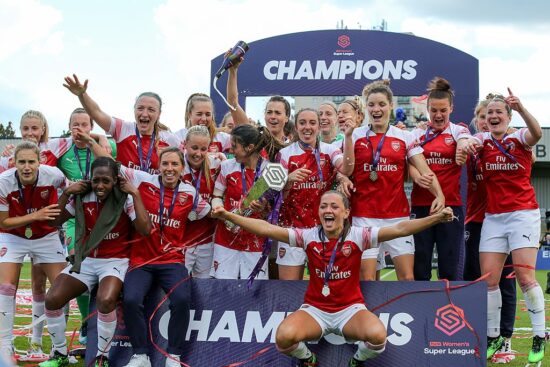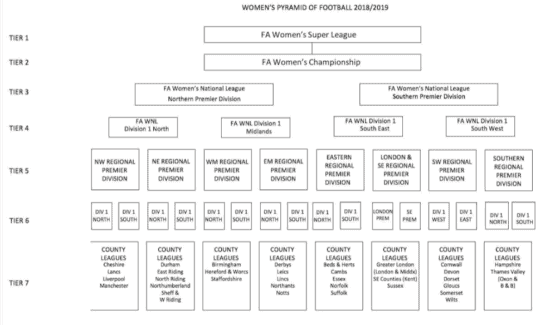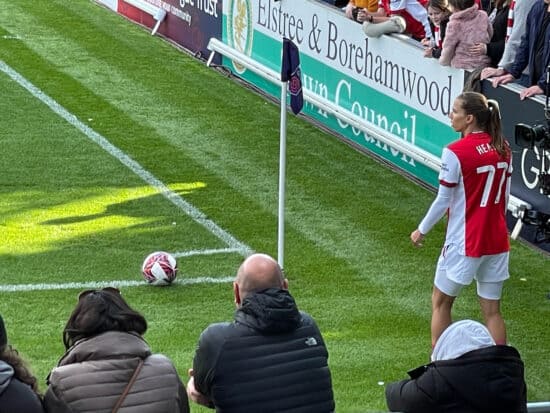Here are the English women’s football schedules and some updates for the 2023-24 season. 2023-24…
Taking a Look at Women’s Football in England

Mea culpa time: Virtually all my efforts to this point have been about men’s, not women’s, English football — but that is changing.
In my book, within each club profile, I mention a little about the women’s team, including their current league and where they play.
But women’s football in England (and all over the world) is growing, so it’s well past time I start writing about the women’s game in England, my current region of “expertise.” I have now been to a few women’s soccer games, but for now, let’s take a look at the history and current state of women’s football in England.
History of Women’s Football in England
Women’s soccer in England as it currently exists is roughly fifty years old. But records of games stretch back to the 1890s, often around pre-existing men’s clubs.
Dick, Kerr Ladies: Pioneers of Women’s Football
Women’s football was quite popular around World War I, particularly a team formed at a company in Preston, Lancashire called Dick, Kerr and Co.; they made locomotives and railcars. One afternoon in 1917, a group of female workers beat the men in a pickup game; somebody suggested forming a team to boost morale, and Dick, Kerr Ladies FC was born.
They immediately began to draw crowds in the thousands, and in 1920 went on their first international tour, to France. The publicity around that led to a Boxing Day 1920 crowd of 53,000 at Everton’s Goodison Park.
Sadly, the men in charge couldn’t take it; boosting morale during the war was one thing, but the Football Association actually banned women’s teams from using men’s club facilities starting in 1921. This effectively killed women’s football in England for 50 years.
The FA’s pigheadedness aside, Dick, Kerr Ladies persevered. They toured America in 1922, changed their name to Preston Ladies FC in 1926, and continued to play and tour until disbanding in 1965. They played 833 games, winning 759, drawing 46, and losing 28.
They are now honored with a display (above) outside Deepdale, home of Preston North End FC, which has also started its own women’s team.

There have been lot of Arsenal trophy celebrations in English women’s football. Here they celebrate the 2018-19 WSL title. Katie Chan, CC BY-SA 4.0, via Wikimedia Commons
After the Ban: English Women’s Football Since 1971
After England won the World Cup in 1966 and set off a wave of popularity for the game, a Women’s Football Association (WFA) was formed in 1969, and in 1970 they started what would eventually become the Women’s FA Cup. In 1971 they earned their first major victory: reversing the FA’s ban on women’s teams using men’s facilities. The WFA was folded into the FA in 1983, and then the FA formally took over all English women’s football in 1993.
The Women’s Premier League was formed in 1992, and slowly men’s clubs began to create women’s teams or link up with preexisting ones. That league morphed into the Women’s Super League (WSL) in 2011, first in a no-relegation format, then split into two divisions with promotion and relegation in 2014. But the WSL only became fully professional in 2018.
The Big Difference Between American Women’s Soccer and English (and Everybody Else’s) Women’s Soccer
In England, women’s teams are overwhelmingly associated with preexisting men’s clubs. This means the financial system makes a lot more sense than in the United States, and the clubs are starting to throw some of that money around. Many of the top US international players have moved to English and European clubs to have the opportunity to play more games and have access to better facilities; we’ll get to them later.
By comparison, for the 2022-23 season, the National Women’s Soccer League in the United States has 12 clubs, with just three of those associated with an existing Major League Soccer club. Two more are associated with second-tier United Soccer League clubs, and one, OL Reign of Tacoma, Washington, is owned by Olympique Lyonnaise of France!
Typically in England, a club’s ladies’ team plays at the men’s team practice facility or a smaller local club’s ground. Some bigger games are being played at men’s stadiums. At the lower levels, it can be hard to track down fixture lists and game information, but wherever I can, I list them in the club profiles of my book. When in doubt, check the men’s club’s website.
The Women’s Football League Pyramid in England
As with the men (here’s a guide), women’s football in England has a pyramid structure for its leagues, all connected by promotion and relegation. At the top is the WSL with 12 clubs. Beneath that in tier 2 lies the Women’s Championship, with another 12 clubs.
The third tier of women’s football is two divisions, Southern Premier and Northern Premier, of the Women’s National League, each with 12 teams.
Tier 4 is the Women’s National League Division 1, with four regional 12-team divisions: Northern, Midlands, South West and South East.
Beyond that it gets super widespread and super amateur and part-time. Tier 5 has eight regional leagues, and below that it’s hard to even find out online who’s in which league.
Focus on the Women’s Super League
Chelsea are defending champions, and they have the all-time lead in titles with five. Arsenal are next with three. But recall that history is only since 2011 in the Women’s Super League. Arsenal won previous incarnations 12 times in 18 years.
The bottom team each season gets relegated to the Championship; after the 2019-20 season, in what feels like a twist that we’ll see more of as we go, Liverpool were relegated — feels funny to read that, no? — to be replaced in the top tier by Aston Villa.
The top two WSL teams go into the second round of the UEFA Women’s Champions League, and the third-place finisher goes into the First Round. That is new as of the 2020-21 season; previously it was just the first place winner.
For this year’s Champions League, England will send Chelsea, Manchester United and Arsenal.
The Women’s FA Cup
There has been a version of the Women’s FA Cup since 1970, though at first it was called the Women’s Football Association Cup, or Mitre Cup since it was sponsored by a sports equipment manufacturer. The WFA ran it for 23 seasons, during which it was dominated by two clubs that fans of the men’s game will have hardly noticed: Southampton and, especially, Doncaster.
Southampton are an interesting story, because they have never been associated with Southampton (Men’s) FC. The Reds, as they are known, were founded in 1970, just as the women’s game was being reborn in England, and they played in the first nine Cup Finals, winning seven of them.
Just the history of those early Cup days is revealing regarding the state of the women’s game back then. In the first 12 Finals, 10 of which included Southampton, none of the other opponents still exist under their name of the time, if at all. Southampton, meanwhile, continue on, although the Premier League men’s club also has an affiliated women’s team (since 2018), and the two are now together in the fourth tier National League Division 1 South West. I assume this is quite the derby!

Doncaster Belles when they were in the WSL, playing at Doncaster Rovers’ Keepmoat Stadium. Clavdia chauchat, CC0, via Wikimedia Commons
Doncaster Belles took over dominating the women’s game in England after Southampton faded. Starting with the 1983 Cup Final, they played in 11 of 12, winning six. For good measure, the Belles won league and cup doubles in the first three years there was a WFA league, winning every game in the league’s first season.
Enter the FA, though: Incredibly, in 2013 during a reorganization of the league pyramid, Belles were simply removed from the top tier by the FA to make way for Manchester City, this over the objections of almost every club in the league (presumably excluding Man City). Belles never made it back and have since merged with the men’s club under the name Doncaster Rovers Belles.
Overall, Arsenal lead the way with 14 Women’s FA Cup wins. Current holders are Manchester City.
The 2020-21 Women’s FA Cup includes 376 clubs, with preliminary rounds for clubs from tiers 5-7, and the top two tiers joining in the Fourth Round Proper. Games are at club grounds through the semifinals, and the Final has been played at Wembley since 2015.
The semis and Final are televised by BBC in England.
The Women’s League Cup
Also known as the Continental Cup for sponsorship reasons, this one is only for the top two tiers and has been played since 2011. Arsenal have five wins since then — notice a pattern? — and Chelsea are current holders.

Lyon of France lifting one of their seven Champions League trophies. Steffen Prößdorf, CC BY-SA 4.0, via Wikimedia Commons
UEFA Women’s Champions League
Let’s take a brief sojourn to Europe, where the top three English women’s teams go each season. The Women’s Champions League is, in the big picture, a largely German affair, although a French club, Olympique Lyonnaise, or simply Lyon, have the most titles with eight since it started in 2009. But four of the seven most successful clubs in terms of making the Final are from Germany, and Frankfurt have won it four times.
The only English team to win it? That’s right, Arsenal, in 2007. Chelsea were runners-up in 2021.
A note on inequality: The winning club of the Women’s Champions League gets 460,000 Euro. The men’s winner gets 23 million.
So far, only the Final of the Women’s Champions League has been on television (it’s on CBS in the US), though more games are on UEFA’s YouTube channel.

Attendance figures in the WSL, minus the “showcase” games. (WSL Attendances on Twitter)
Women’s Football Attendance in England
In the 2019-20 season, Tottenham led the league with an average of 8,600 fans, while playing mostly at The Hive, home of non-league Barnet FC in North London. Man City play on the Etihad campus, and Arsenal play at the home of Boreham Wood FC. The rest of the WSL averages in the 1,000 to 5,000 range, but there have been much bigger crowds. Average attendance in the WSL has had a more than 200% increase since the 2019-20 season, with the average attendance now around 6,000.
For example, Arsenal-Tottenham at The Emirates drew more than 47,000; Man City vs Man United got 31,000; and both Chelsea-Spurs and West Ham-Spurs got more than 24,000.
Take away those “showcase” games, and you can see the average attendances by club up above.
Good at Men’s Soccer, Not at Women’s
I previously mentioned Liverpool getting relegated, so it’s interesting to see where English clubs are better at men’s football than women’s. Down in the second tier Championship, some names will look familiar: Liverpool are currently playing Leicester City, Crystal Palace, and Sheffield United. A tier below that, one will find West Bromwich Albion and Burnley.
What’s more interesting, in terms of learning about the women’s game in England, is when it’s the other way around:

Home game at Lewes FC. (Me677, Public domain, via Wikimedia Commons)
English Clubs Good at Women’s Football, Not at Men’s
Let’s start in the WSL, where among the familiar London and Manchester names you’ll also see some from the men’s Championship: Bristol City, Birmingham City, and Reading.
In the Championship, some names will really jump out at someone who only follows the men’s game: Coventry United, Durham (a completely independent outfit from the North East), Lewes (near Brighton, associated with a men’s team playing in the seventh-tier Isthmian League), and the London City Lionesses, who broke away from Millwall FC in 2019.
Below these are many clubs you will probably have never heard of. Just a sampling of some names from the third tier: Fylde, Loughborough Foxes, Sheffield FC (associated with the oldest men’s club in the world), Chichester and Selsey, Crawley Wasps, Hounslow, and Keynshan Town.
One wonders, as investment from men’s clubs continues to grow, how long some of the smaller and independent clubs can stay this far up the ladder.

The “Lionesses” at the 2019 Women’s World Cup. Liondartois, CC BY-SA 4.0, via Wikimedia Commons
The English Women’s National Team
Playing internationally since 1972, the Lionesses (or the Three Lionesses) have made five World Cups, their best performances being third in 2015 and fourth in 2019. They also made the European Final in 1984 and 2009.
With one exception — Rachel Daly of the Houston Dash — the rest of the 21-woman roster plies their club trade in England. Eight of them are with Manchester City and four play for Chelsea.
The Lionesses also recorded the fourth largest crowd at a women’s soccer game, 87,192, at their win at Wembley Stadium on July 21, 2022 against Germany in the Euro 2022 Final.
American Women Playing Football in England
And finally, since I and many of my readers are American, and since the Americans are the gold standard of international women’s football, let’s take note of which American women — all members of the two-time defending World Cup Champions — currently play in England, and which NWSL team they were with previously.
As you can see below, they are all in Manchester!
Abby Dahlkemper, Manchester City via North Carolina Courage
Tobin Heath, Manchester United via Portland Thorns (and previously Paris Saint Germain in 2013-14)
Rose Lavell, Manchester City via Seattle (now OL) Reign
Sam Mewis, Manchester City via North Carolina Courage
Christen Press, Manchester United via Utah Royals (RIP)
Alex Morgan is now back with Orlando Pride of the NWSL after playing with Tottenham Hotspur.











Post Comments
Paul,
Thanks for including this bit on Women’s football. After all, it was the women that got me and my wife interested iniitally: first watching our daughter and then the U.S. women’s national team. Only later did we become interested in watching the men’s English Premier league.
Keep up the good work.
Thanks so much! I’m way behind on this, but I look forward to seeing some games in person when I get over there. And I miss my Portland Thorns as well.